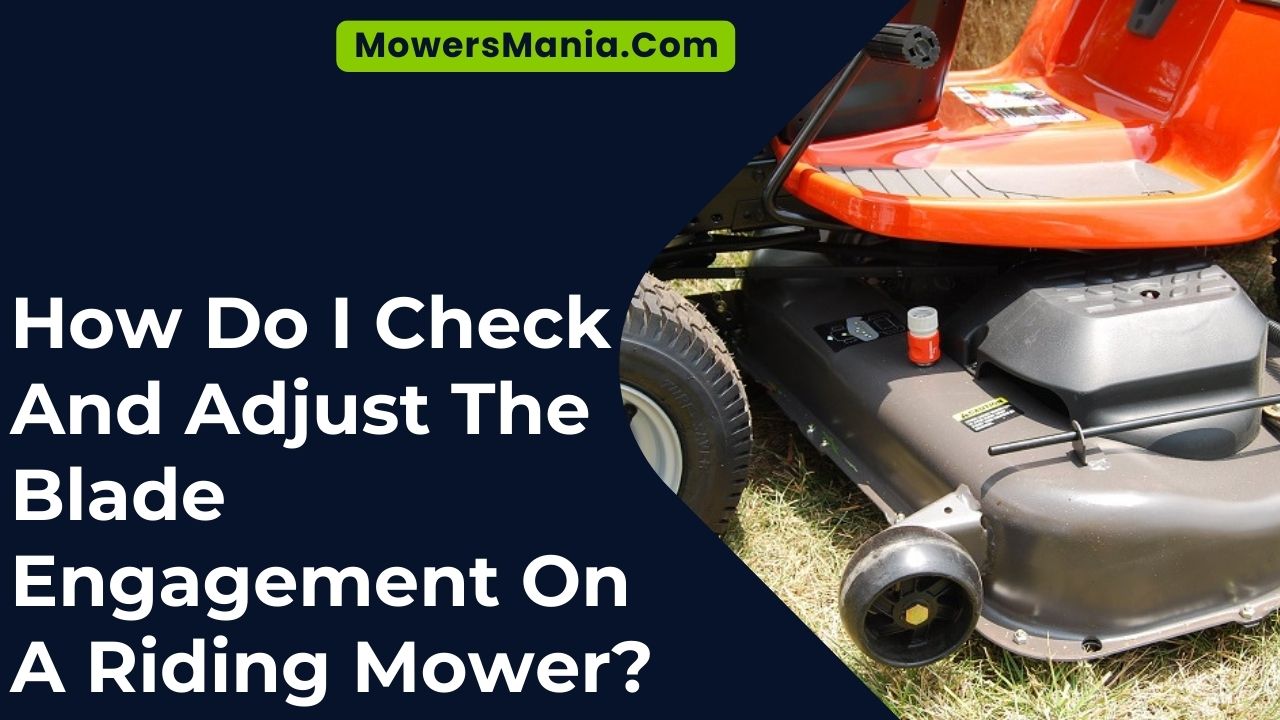So, you’ve been noticing uneven mowing patterns on your lawn despite having recently serviced your riding mower. You might be surprised to learn that the issue could be related to the blade engagement.
Understanding how to check and adjust the blade engagement on your riding mower is crucial for maintaining a well-kept lawn.

Whether you’re a seasoned mower operator or just starting out, knowing the ins and outs of this mechanism can save you time and frustration in the long run.
But how do you ensure that the blade engagement is properly set for optimal performance and safety? Let’s explore the steps to take and the factors to consider when dealing with this essential aspect of your riding mower.
Importance of Blade Engagement
Ensuring proper blade engagement is crucial for achieving an even and clean cut when mowing with a riding mower. When the blades aren’t fully engaged, the grass may be left unevenly cut, leading to an unsightly lawn.
On the other hand, over-engaging the blades can put unnecessary strain on the mower’s engine and belts, potentially causing damage over time.
Proper blade engagement ensures that the grass is cut to the desired height in a single pass, reducing the need for multiple mowing sessions. This not only saves time but also conserves fuel and reduces wear and tear on the mower.
Additionally, when the blades are engaged correctly, the mower’s performance is optimized, resulting in a more efficient cutting process.
By maintaining the right blade engagement, you can also prevent potential safety hazards. Blades that aren’t fully engaged can leave behind patches of uncut grass, which may become potential hiding spots for debris or even small animals.
Understanding Blade Engagement Mechanism
When engaging the blades on a riding mower, it’s important to understand the mechanism that controls their operation.
The blade engagement mechanism on a riding mower is responsible for enabling and disabling the blades’ rotation.
This mechanism typically consists of a few key components that work together to ensure the safe and efficient operation of the blades. Understanding these components and how they function is crucial for proper maintenance and adjustment.
| Component | Function | Common Issues |
|---|---|---|
| PTO (Power Take-Off) | Transfers power from the engine to the blades | PTO clutch may fail or disengage unexpectedly |
| Deck Lever | Controls the position of the mower deck | Deck lever may become stuck or difficult to operate |
| Safety Switches | Prevents the blades from engaging when unsafe | Safety switches may malfunction, preventing blade engagement |
| Deck Belt | Transfers power from the PTO to the blades | Deck belt may slip or wear out, affecting blade rotation |
| Blade Engagement Switch | Activates the blade engagement mechanism | Switch may fail, preventing blade operation |
Understanding how these components interact and being able to identify common issues will help you diagnose and address any problems with the blade engagement mechanism on your riding mower.
Steps to Check Blade Engagement

First, locate the blade engagement switch on your riding mower. Then, visually inspect the engagement mechanism to ensure it’s free of debris or obstructions.
Blade Engagement Switch
To verify the proper functionality of the blade engagement switch on your riding mower, carefully inspect the switch for any signs of wear or damage before use.
A damaged or worn switch can lead to issues with engaging or disengaging the mower blade, which can be dangerous and also affect the quality of your lawn care.
Below is a table to help you understand the potential issues and their corresponding emotional impact.
| Potential Issue | Emotional Impact |
|---|---|
| Switch is damaged | Frustration |
| Switch is worn | Concern |
| Switch is malfunctioning | Anxiety |
| Switch is in good condition | Relief |
| Switch is easy to engage | Satisfaction |
Regularly checking and maintaining the blade engagement switch can help ensure safe and efficient operation of your riding mower.
Visual Inspection
After inspecting the blade engagement switch for any signs of wear or damage, visually examine the engagement mechanism for proper alignment and functionality. Look for the following:
- Belt Tension: Check that the belt driving the blades is taut and in good condition.
- Pulley Alignment: Ensure that all pulleys involved in the blade engagement system are properly aligned.
- Spring Condition: Verify that the spring responsible for tensioning the blade engagement system is intact and functioning.
- Linkage Integrity: Inspect the linkage connecting the blade engagement lever to the engagement mechanism for any signs of wear or damage.
Careful visual inspection of these components will help you identify any issues with the blade engagement system and ensure proper functionality of your riding mower’s blades.
Adjustment Procedure
When checking blade engagement on your riding mower, carefully evaluate the smoothness of the engagement process and the tightness of the belt driving the blades.
Start by parking the mower on a flat, level surface and engaging the parking brake. Turn off the engine, remove the key, and disconnect the spark plug wire for safety.
Then, inspect the engagement lever and cable for any signs of wear or damage. Adjust the engagement cable if necessary to ensure proper tension.
Next, check the condition of the mower deck belt and adjust its tension according to the manufacturer’s specifications.
Adjusting Blade Engagement
To adjust the blade engagement on your riding mower:
- Start by locating the blade engagement lever. This lever is usually found on the control panel.
- Once you’ve located the lever, you can then proceed to make any necessary adjustments to the belt tension for optimal blade engagement.
This will ensure that your mower’s blades are properly engaged and operating at their best.
Blade Engagement Lever
Ensure that the blade engagement lever is fully disengaged before attempting to adjust the blade engagement on your riding mower. The blade engagement lever controls the blades’ engagement and disengagement, allowing you to safely adjust the blades.
Follow these steps to properly handle the blade engagement lever:
- Park the mower on a flat surface and turn off the engine.
- Disengage the power take-off (PTO) switch to stop the blades from turning.
- Locate the blade engagement lever, usually found on the control panel.
- Carefully move the lever to the disengaged position, ensuring it’s fully disengaged before making any adjustments.
Belt Tension Adjustment
For adjusting the blade engagement on your riding mower, begin by checking and adjusting the belt tension.
Start by locating the belt that drives the blades. If the belt feels loose or shows signs of wear, it may need adjustment or replacement.
To adjust the belt tension, locate the tensioning system, which may involve adjusting the position of the pulleys or using a tensioning bolt. Consult your mower’s manual for specific instructions on adjusting the belt tension.
Once you’ve located the tensioning system, follow the manual’s guidance to tighten the belt to the appropriate tension.
Ensure that the belt isn’t overly tight, as this can cause excessive wear on the belt and pulleys. Proper belt tension is crucial for optimal blade engagement and overall mower performance.
Safety Precautions for Blade Engagement
Before engaging the blades on your riding mower, always make sure to clear the mowing area of any obstacles or debris. Safety is paramount when operating a riding mower, especially when engaging the blades.
Here are some essential safety precautions to keep in mind:
- Inspect the Cutting Area: Before engaging the blades, carefully inspect the cutting area for any potential hazards such as rocks, branches, or other debris that could be thrown by the blades.
- Check for Proper Clearances: Ensure that there are no bystanders, pets, or children in the vicinity of the mowing area before engaging the blades to prevent any accidents or injuries.
- Wear Appropriate Safety Gear: Always wear appropriate safety gear, including eye and ear protection, when engaging the blades to safeguard yourself from flying debris and loud noise.
- Follow Manufacturer’s Guidelines: Adhere to the manufacturer’s guidelines and recommendations for blade engagement, as failing to do so could result in damage to the mower or potential safety hazards.
Maintenance Tips for Blade Engagement

To maintain optimal performance of your riding mower, routinely inspect and adjust the blade engagement mechanism.
Regularly check for any signs of wear and tear on the blade engagement components such as the pulleys, belts, and springs.
Look for any loose or damaged parts that may affect the proper engagement of the blades. If you notice any issues, promptly replace or tighten the affected parts to ensure smooth and efficient blade engagement.
Additionally, it’s important to keep the blade engagement system well-lubricated. Apply grease or lubricant to the pivot points and moving parts of the blade engagement mechanism to prevent rust and corrosion. This will help maintain smooth operation and extend the lifespan of the components.
Furthermore, always follow the manufacturer’s recommended maintenance schedule for your riding mower.
Regularly servicing the blade engagement system according to the manufacturer’s guidelines will help prevent premature wear and ensure the safe and effective operation of your mower.
Frequently Asked Questions [FAQs]
Can I Use the Same Method to Check and Adjust the Blade Engagement on Different Brands of Riding Mowers?
Yes, you can use the same method to check and adjust the blade engagement on different brands of riding mowers. Ensure safety measures, locate the blade engagement lever, and follow the manufacturer’s guidelines for proper adjustment.
How Often Should I Check and Adjust the Blade Engagement on My Riding Mower?
You should check and adjust the blade engagement on your riding mower at the start of each mowing season and periodically throughout the season to ensure safe and efficient operation. Regular maintenance helps prevent issues.
Is It Possible to Over-Tighten the Blade Engagement Mechanism, and What Are the Consequences if I Do?
Yes, it’s possible to over-tighten the blade engagement mechanism on your riding mower. This can cause excessive wear on the clutch, belts, and pulleys, leading to premature failure. Regularly check and adjust the blade engagement to avoid this issue.
What Are the Signs That Indicate the Blade Engagement Mechanism Needs to Be Replaced?
If you notice excessive vibration, strange noises, or difficulty engaging/disengaging the blades on your riding mower, it’s likely time to replace the blade engagement mechanism. This can help ensure smooth operation and prevent further damage.
Are There Any Specific Lubricants or Cleaning Products Recommended for Maintaining the Blade Engagement Mechanism?
For maintaining the blade engagement mechanism on a riding mower, use a silicone-based lubricant for smooth operation. Avoid using heavy oils or grease as they can attract dirt and cause the mechanism to get clogged. Regular cleaning with a mild solvent is recommended.
Conclusion
So, there you have it! Checking and adjusting the blade engagement on your riding mower is essential for maintaining a well-functioning and safe machine.
By understanding the mechanism, following the steps, and taking necessary safety precautions, you can ensure that your mower is in top-notch condition.
Don’t forget to regularly maintain the blade engagement to prolong the life of your mower and keep it running smoothly.
Happy mowing!



